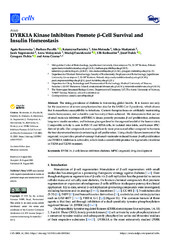| dc.contributor.author | Barzowska, Agata | |
| dc.contributor.author | Pucelik, Barbara | |
| dc.contributor.author | Pustelny, Katarzyna | |
| dc.contributor.author | Matsuda, Alex | |
| dc.contributor.author | Martyniak, Alicja | |
| dc.contributor.author | Stępniewski, Jacek | |
| dc.contributor.author | Maksymiuk, Anna | |
| dc.contributor.author | Dawidowski, Maciej | |
| dc.contributor.author | Rothweiler, Ulli | |
| dc.contributor.author | Dulak, Józef | |
| dc.contributor.author | Dubin, Grzegorz | |
| dc.contributor.author | Czarna, Anna | |
| dc.date.accessioned | 2022-01-07T13:54:58Z | |
| dc.date.available | 2022-01-07T13:54:58Z | |
| dc.date.issued | 2021-08-31 | |
| dc.description.abstract | The rising prevalence of diabetes is threatening global health. It is known not only
for the occurrence of severe complications but also for the SARS-Cov-2 pandemic, which shows
that it exacerbates susceptibility to infections. Current therapies focus on artificially maintaining
insulin homeostasis, and a durable cure has not yet been achieved. We demonstrate that our set
of small molecule inhibitors of DYRK1A kinase potently promotes β-cell proliferation, enhances
long-term insulin secretion, and balances glucagon level in the organoid model of the human islets.
Comparable activity is seen in INS-1E and MIN6 cells, in isolated mice islets, and human iPSCderived β-cells. Our compounds exert a significantly more pronounced effect compared to harmine,
the best-documented molecule enhancing β-cell proliferation. Using a body-like environment of the
organoid, we provide a proof-of-concept that small–molecule–induced human β-cell proliferation
via DYRK1A inhibition is achievable, which lends a considerable promise for regenerative medicine
in T1DM and T2DM treatment. | en_US |
| dc.identifier.citation | Barzowska, Pucelik, Pustelny, Matsuda, Martyniak, Stępniewski, Maksymiuk, Dawidowski, Rothweiler, Dulak, Dubin, Czarna. DYRK1A kinase inhibitors promote β-cell survival and insulin homeostasis. Cells. 2021;10(9) | en_US |
| dc.identifier.cristinID | FRIDAID 1943960 | |
| dc.identifier.doi | 10.3390/cells10092263 | |
| dc.identifier.issn | 2073-4409 | |
| dc.identifier.uri | https://hdl.handle.net/10037/23632 | |
| dc.language.iso | eng | en_US |
| dc.publisher | MDPI | en_US |
| dc.relation.journal | Cells | |
| dc.rights.accessRights | openAccess | en_US |
| dc.rights.holder | Copyright 2021 The Author(s) | en_US |
| dc.subject | VDP::Mathematics and natural science: 400::Chemistry: 440 | en_US |
| dc.subject | VDP::Matematikk og Naturvitenskap: 400::Kjemi: 440 | en_US |
| dc.subject | VDP::Medical disciplines: 700::Clinical medical disciplines: 750::Endocrinology: 774 | en_US |
| dc.subject | VDP::Medisinske Fag: 700::Klinisk medisinske fag: 750::Endokrinologi: 774 | en_US |
| dc.title | DYRK1A kinase inhibitors promote β-cell survival and insulin homeostasis | en_US |
| dc.type.version | publishedVersion | en_US |
| dc.type | Journal article | en_US |
| dc.type | Tidsskriftartikkel | en_US |
| dc.type | Peer reviewed | en_US |


 English
English norsk
norsk